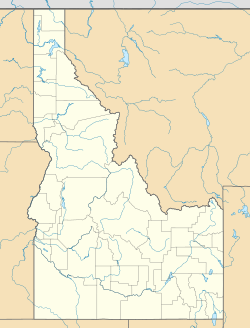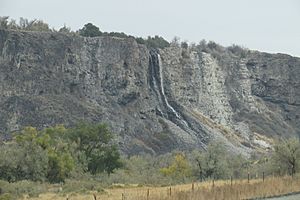Priestly's Hydraulic Ram facts for kids
Quick facts for kids |
|
|
Priestly's Hydraulic Ram
|
|
| Nearest city | Hagerman, Idaho |
|---|---|
| Area | less than one acre |
| Built | 1890 |
| Architect | William W. Priestly |
| NRHP reference No. | 75000631 |
| Added to NRHP | February 13, 1975 |
The Priestly's Hydraulic Ram was a special kind of pump. It was invented and built around 1890 by William W. Priestly. This amazing machine was located in Gooding County, Idaho, near Hagerman, Idaho. Its main job was to move water uphill. This water was then used to irrigate, or water, farm fields. These fields were on a high plateau above the Snake River.
The ram was found about 6 miles (10 km) south of Hagerman. This area is now part of Thousand Springs State Park. Because it was such an important invention, Priestly's Hydraulic Ram was added to the National Register of Historic Places in 1975. This list keeps track of important historical places in the United States.
Contents
How It Started
William W. Priestly began working on this project in 1888. His big idea was to create a way to water the farms south of Hagerman. He wanted to use the natural water that flowed out of the Snake River Aquifer. This water came out of the ground as springs and formed waterfalls down the side of the Snake River Canyon.
Priestly's goal was to pump this water all the way to the top of the cliff. The ram used the power of falling water to push other water up the cliff. It was a clever way to use nature's energy.
Building the Ram
Even though the ram is named after Priestly, some people think David Hyde might have actually built it in 1901 or 1902. While the ram was being built, another company, North Side Irrigation, created a different watering system. Because of this, it seems Priestly's ram was never used to water farms for money. However, reports from 1901 say it was working at that time.
Another story says that Priestly built the ram in 1894. This account says he successfully lifted water 75 feet (23 meters) high and used it for irrigation. Later, Priestly became interested in finding gold. In 1896, he used the same air-ram idea to build a machine for digging gold from rivers, called a gold dredge.
How It Worked
The Priestly's Hydraulic Ram was quite amazing because it had no moving parts! It used a clever design to move water.
The Ram's Design
First, the ram used large pipes, about 24 inches (61 cm) wide, to collect spring water. This water was mixed with air. The water and air then fell downhill about 190 feet (58 meters) into a big metal tank.
The special design of this tank made the water flow out into the river. But as it flowed, it used the kinetic energy (the energy of movement) of the falling water. This energy was used to push air uphill through a second pipe. This air went to a smaller ram's tank.
This smaller ram was fed by water that dropped 60 feet (18 meters) from an even higher spring through a third pipe. The air pressure from both rams then combined. This combined pressure pushed water 110 feet (34 meters) up to the top of the cliff through a fourth, smaller pipe.
People at the time thought Priestly's hydraulic ram was truly wonderful. It was a very smart way to use water power.
Other Rams
A similar, but simpler, ram was built in Arizona a few years before Priestly's. However, people believe Priestly designed his ram all by himself. Other similar devices were built around the same time in places like Montreal, Quebec (1896), Ainsworth, British Columbia (1898), and Norwich, Connecticut (1902).
Even though these rams were about 70% efficient (meaning they used 70% of the energy they took in), they didn't become widely used. Soon, newer pumps powered by steam, gasoline, and electricity became available. These new pumps were even more efficient.
Still, Priestly's ram is important. It is seen as one of the few truly original inventions in how power was moved and used in the United States.
What's Left Today
In 1974, when the ram was nominated for the National Register of Historic Places, parts of the pipeline and the storage tank were still there. Photos from 1973 showed a pipeline and the reservoir.
However, it's not clear what happened to these pieces after that. An archaeologist from Idaho Power Company, Shane Baker, said that the parts might have been taken apart and reused. Or they might have been moved somewhere else, or just left where they were. No one has found any parts of the ram today. It's also possible that the first hydroelectric power plant built at Thousand Springs in 1912 was built right over where the old ram used to be.




